
It’s funny how moving homes motivates you to visit the things you thought you always would, but somehow never did. Those famous local places that you assumed would always be on your doorstep, but then one morning you wake up to find you have a completely new doorstep, and those hitherto local places…..aren’t.
Earlier this year, after 12 years in Fife, I moved to Braemar. Obviously, I love my new doorstep. It’s the Cairngorms for goodness sake! But it’s also about as far from the coast as you can get, and I do miss having the sea close by.
True, I never spent a huge amount of time on the Fife coast but I could see the sea from my former home in the Lomond Hills, and simply knowing it was within reach was oddly comforting.
But the move suddenly put the Fife coast out of easy reach, ramming home how little of the Fife Coastal Path I’d walked. Sure, I’d visited many places along its length over the years, but I’d tended to walk the same few sections over and over.
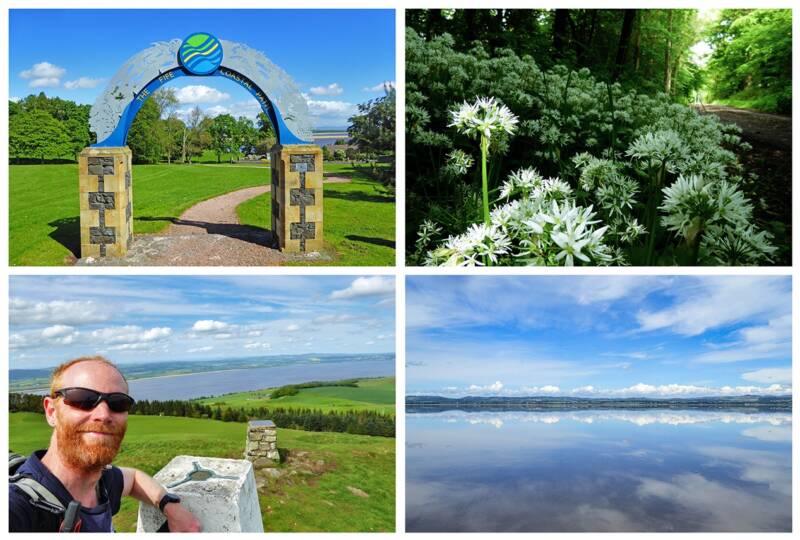
When family came to visit it was Pittenweem to St Monans. For seal watching it was Kirkcaldy to Kinghorn. With my partner it was Elie to Shell Bay. And if I was walking by myself then it was Balmerino to Birkhill. What about the rest?
I therefore resolved to spend Summer 2022 doing the Fife Coastal Path in sequence. I thought it would be a good project until the snowy hills returned but I didn’t much fancy doing it all in one go. I wanted to be able to choose good weather days rather than being committed to a fixed multi-day window where anything could happen. Plus, I really hate lugging big heavy packs around.
THE LOWDOWN
The Fife Coastal Path was launched in 2002, connecting North Queensferry to Tayport. In 2011 the section west of the Forth bridges to Kincardine was added, followed by the section west of the Tay Bridge to Newburgh in 2012. Today the coastal path is 188km long, linking Kincardine on the Forth to Newburgh on the Tay.
Suggested times for walking the whole thing are between seven and ten days, depending on how much walking you want to do. There’s no right or wrong way to do it, but most folk seem to do it anticlockwise from Kincardine to Newburgh. I did it the other way around. Partly because I liked the idea of seeing the Forth Bridges from afar for most of my journey along the Forth coast, but mainly because I’m a natural contrarian.
I didn’t want massively long days either, primarily because I knew there’d be too much to see. But I also wanted plenty of time to sit and drink coffee, to have fish and chips, to faff.
So, between May and October, using only very lovely weather, I spent nine days on the coastal path as shown below. I used my car to get to each starting point. I had to get a lift back again on stages 1 and 2, but on stages 3 to 9 I was able to use Stagecoach or Moffat & Williamson buses to get back to where I’d started.
- Newburgh to Hazelton Walls – 16.5km
- Hazelton Walls to Tayport – 16.5km
- Tayport to St Andrews – 27km
- St Andrews to Crail – 22.6km
- Crail to Elie – 16.7km
- Elie to East Wemyss – 21.3km
- East Wemyss to Burntisland – 21km
- Burntisland to Rosyth – 23.6km
- Rosyth to Kincardine – 24.7km
A ROUTE OF CONTRASTS
I imagine most folk think of the famous ‘whitewashed’ East Neuk when they think of the Fife coast, but that stretch between Kingsbarns and Earlsferry comprises only 32 of the 188 kilometres. So while undeniably beautiful and justly famous, the East Neuk isn’t representative of the Fife coast as a whole. You get magnificent contrasts and amazing variety the whole way around.
I’d heard of folk eschewing the stretch between Newburgh and Tayport on account of it not being ‘interesting’ and, heaven forbid, veering between 1 and 2km inland for a total distance of about 16km. Most of that section was completely new to me, but from the outset it confidently signalled its uniqueness, fringed as it was by the yellow glow of reed beds, 17km long! That makes them the longest continuous such habitat in the UK, home to marsh harriers and bearded tits. These reeds went up in smoke in April 2020, so it was great to see they’d recovered.
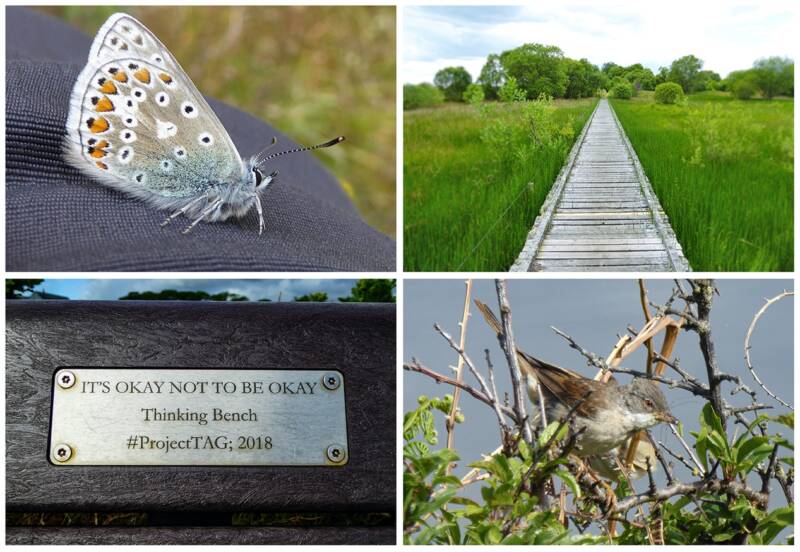
Climbing out of Newburgh, through a rich agricultural landscape, I was only 90m above sea level but the views upstream towards Moncreiffe and Kinnoull Hill and beyond, all the way to Stuc a’ Chroin and Ben Vorlich, were massive.
It’s true that as the path veers around Glenduckie Hill any pretence of it being a coastal path feels fanciful, but it’s no less beautiful for it. Fife excels at this kind of quiet bucolic countryside, and the airy, grassy walking from Newburgh up to that point is sublime.
The route then reaches a lofty altitude of 230m, from where it’s less than 0.5km and a short 50m climb to the top of Norman’s Law. I already knew this hill and its expansive coastal view well, so eagerly made the short side-trip to its summit. It’s easily the best viewpoint on the whole coastal path, and not to be missed!
When the path finally does return to the coast west of Balmerino, the woodland tumbling (in places quite literally) into the Tay is unlike anywhere else in Fife. Lush, quiet and surprisingly wild despite the close proximity of Dundee over the water. Wild garlic and bluebells thrive here in what is the largest and least disturbed area of mixed deciduous woodland in Fife. And although the Tay is a seriously tidal and turbulent place, when I passed by it was a vision of serenity. The water was like glass, reflecting the cloudscapes and distant Braes of Carse.
The 37km from Balmerino to St Andrews was completely new for me. The path gains height towards Wormit and the views are obscured by dense summer woodland. But I could still hear the coast via the mournful cries of seals on the Tay sandbanks.
The biggest single feature on that coastline is Tentsmuir National Nature Reserve. Designated for its dynamic coastline and its mix of dunes, heath and lochs, it’s home to large populations of common and grey seals, is one off the most important sites in Scotland for migratory waders, and is a haven for butterflies, moths and beetles. Storm Arwen has left a real mess, though. Scotland lost 8 million trees to the storm one year ago, and as I walked through the forest it felt like most of them were there.
Perhaps the biggest surprise for me on this stretch, from a nature perspective, was Earlshall Muir SSSI, near Leuchars. Exiting Tentsmuir, I hadn’t seen or heard the coast in more than 6km, but after going through a gate and unexpectedly emerging into sandy open grass/heathland unlike anything I’ve ever seen, I really couldn’t care less!
This was one of my highlights of the whole coastal path. The SSSI citation describes it as ‘one of the few remaining examples in Scotland of a dune system exhibiting a complete succession of vegetation from accreting mobile dunes through to birch and alder woodland’, which I admit sounds incredibly niche. But put simply, it’s not your average habitat. The spacious and open ground interspersed with clumps of woodland and scattered trees reminded me, weirdly, of savannah. I spent half an hour chasing down every flying insect that passed by – click beetles, moths, fritillaries, there was so much to see! I even encountered a Mother Shipton moth, so named because it carries the profile of the 16th Century Yorkshire ‘witch’ on each wing. Skylark song filled the sky and I made a note to come back another time.
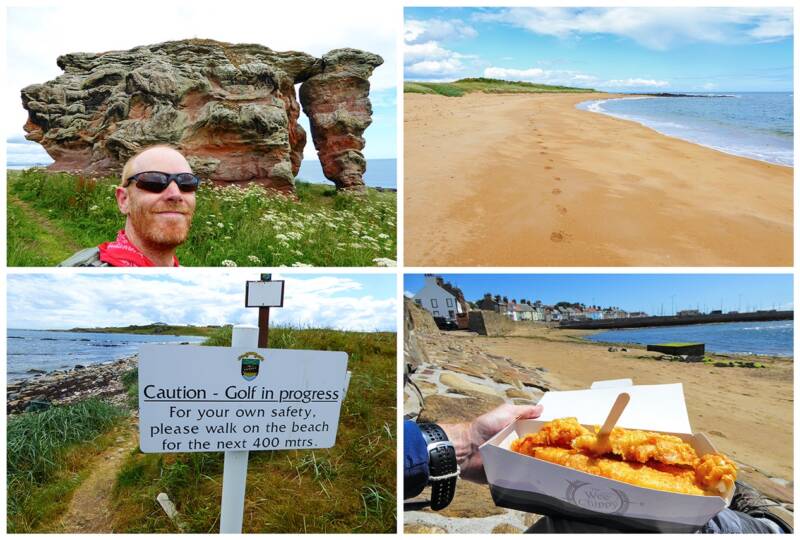
Beyond the Eden and St Andrews is the exposed and ruggedly rocky coast that winds its way down towards Kingsbarns and the East Neuk. If you like big freaky rocks then this is the section for you, home as it is to noteworthy volcanic formations and curious sandstone sea stacks marooned on raised beaches.
Someone did once tell me that there were a lot of golf courses on this stretch of coast too, but I don’t remember seeing any. Presumably they’re rather unassuming, well-scattered affairs that blend seamlessly into the landscape.
Around Fife Ness and yep, this is the picture postcard whitewashed seascape of the East Neuk ports, where the older village centres have that distinctive ‘Low Country’ architecture –crow-stepped gables reflecting the historic links with Flemish traders.
Moving west along the Forth coast you get a more expansive ‘ocean’ feel than on the Tay. The sky feels bigger, with ever-changing views of the Forth Islands. All the while the Pentlands and Edinburgh grow larger as you move your way down the increasingly densely populated coastline towards the Forth Bridges, beyond which it all takes on a tidal feel again as you make your way to Kincardine.
Ultimately it’s very much a working landscape, constantly changing as you pass through 40 or so towns and villages. Despite this, and as busy as the coastline can be, settlement edges are for the most part clearly defined, which gives the natural world plenty of space to breathe.
Nature was therefore a constant companion on my walk. Gorse, blackthorn, sea buckthorn and thrift. Yellowhammers in the fields, stonechats on the fences, whitethroats in the hedgerows, and waders on the beaches.
Fife still has some red squirrels clinging-on, so the north coast woodlands and Tentsmuir occasionally yield a sighting, as they obligingly did for me when I passed through. White tailed eagles are not uncommon here either, having successfully raised chicks on this coast since 2013.
From the seafront in the heart of Leven I watched the occasional terns and gannets diving into the surf. Even on Kirkcaldy prom, with the smell of curry houses in the air and cars whizzing past, a seal swam parallel to me, not 20m offshore, for the entire mile.
Dolphins and porpoises are pretty routine sights in summer, and there have been humpback whales in the Forth recently too. I had no such luck on the cetacean count, other than an unidentified and unbelievably smelly dead whale on the beach at St Monans.
Sadly, Avian Flu was a conspicuous companion all along the Forth coast, and impossible to ignore. I counted 20 dead gannets between Crail & Cellardyke, 25 between Pittenweem & Elie. As such, the beautiful gannet mural on Pittenweem’s communal shelter, painted only this summer by Dundee artist Paco Graff, seemed unintentionally poignant.

Drought was a companion too, as Fife was suffering its 10th driest summer in 100 years, with lowest groundwater levels on record. Not surprising, therefore, that Kincraig Point, rather than wearing its usual summer cloak of knapweed and other colourful wildflowers, was a brown sun-baked husk.
A ranger sign on the slopes asked ‘Have you seen a Northern Brown Argus? Nope, I hadn’t. In fact I hadn’t seen ANY species of butterfly that day. Not a single one in 8km!!! Really not good on a warm sunny day at the height of summer. Warm, settled summers can be good for butterflies, yes, but not if all their food-plants wither and die.
OH, THE BEACHES!
Warm sunny weather is, however, ideal for beaches if that’s your thing, and there’s no shortage of those. Along the more estuarine stretches the mudflats dominate but even there you’ll find lovely narrow shingle beaches above the strand line.
Between Tentsmuir and Aberdour the beaches are mostly sandy, including the odd white sun-bleached shell one too, but there are too many beaches to count. Some are just 50m long, others measured in kilometres. But most of them are isolated enough or large enough to swing several hundred humongous cats, not least in the vast arc of Largo Bay, Tentsmuir Sands, or Pettycur and Elie at low tide.
At times the beaches themselves ARE the coastal path, either because of adjacent steep ground or the omnipresent ‘death by golfball’ hazard. Yep, I lied earlier. But on beautiful beaches like Balcomie or at Airbow Point, that’s really no hardship. You do however need to be vigilant at a couple of beachy pinch-points, as high tides can leave you stranded. Erm….no, that certainly didn’t happen to me at Pettycur. Absolutely not!
MANY LIFETIMES OF DISTRACTIONS
This is Scotland of course, and so the Fife Coastal Path isn’t just about nature and seascapes. Culture and history are everywhere: coal mines; castles; World War 2 defences; streets named for witches; old ferry terminals; abbeys; viaducts; lighthouses; abandoned salmon bothies; a poignant memorial to the Tay Bridge Disaster.
History just sort of tumbles down in front of you, like in Lower Largo where I was unexpectedly greeted by a statue of Robinson Crusoe. Or rather, his supposed inspiration Alexander Selkirk, who was born there and later castaway alone in the south Pacific for four years.
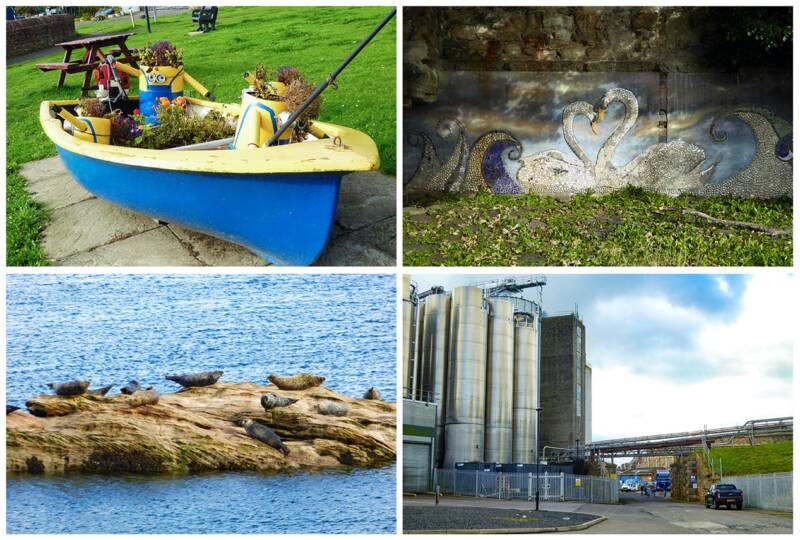
It all sits seamlessly alongside modern Fife, forging ahead as a ‘Kingdom’ of industry and innovation, tourism and commerce. And of course there are a few genuinely iconic sights along the way, not least the Forth Bridges.
Personally, as someone who favours natural environments over any other, I was therefore wary about the prospect of so much urban walking. The path does, after all, run through dozens of settlements, and while some are tiny with just a few dozen inhabitants, others are among the largest conurbations in Fife.
I anticipated I’d scurry through the less obviously historic places, such as Leven, Kirkcaldy, Rosyth. But I’m pleased to say that my walk along the Fife Coastal Path did, in part at least, cure me of this urban reticence, for there wasn’t anywhere that didn’t have something of interest. Even a deserted, empty and soulless road in the Port of Rosyth, flanked by industrial wasteground, made me smile with its picture-perfect autumn leaf-fall onto the pavement. It was actually the built and the human environments that surprised and delighted me the most. Who’d have thought?
I loved West Wemyss’s peculiarly ornate townscape, and Dysart’s enormous harbour wall. The Argyll-style steeply wooded seafront at Limekilns was a surprise, as was Ravenscraig Castle, perched next to high-rise flats above a beautifully craggy beach in Kirkcaldy.
Buckhaven in particular was fascinating. I knew nothing about it beforehand, but I found colourful murals painted on the ground and on buildings, and the unique architecture of Denbeath Garden City, a purpose-built community built by the Wemyss Coal Company in 1904/5 to accommodate its miners. And above Buckhaven Bay were giant ‘jawbanes’ – oak replicas of original whale bones that once stood here as a nod to its fishing industry.
I know there’s been conscious effort recently to regenerate the town, and while I can’t say how locals feel about it, I certainly left Buckhaven with a strong sense of community, history and civic pride, and could easily have spent an afternoon there, learning much more.
St Andrews, of course, is the most famous and, in terms of crazy bustle, biggest attraction on the coastal path. The Open was looming when I passed through and the carnival was already in town. It was also graduation day at the university, so with all the tourists and students, and more people in suits and high-end garb than I’ve seen in all my years in Fife, it felt a bit like I’d arrived on a film set.
It’s that unreality that stokes a love/hate relationship with St Andrews. On the one hand I find it utterly alien, as theme park, like another country within Fife. But on the other it’s impossible not to be drawn in by its beauty, history & vibrancy. Still, it was way too busy for this Braemar boy so I headed down to Castle Sands to soak my feet.
There was a lovely vibe down at the water. People swimming, laughing, eider ducks doing their best Frankie Howerd impressions, kids playing on the rocks. And it’s that kind of thing, the ‘everyday’ human element and above all, the quirkiness, that I enjoyed most about my walk along the Fife coast. That familiar mix of everyday and holiday.
The jetties with rowing boats marooned by the tide. Static caravans and benches with a heavenly view. Serene waterfronts way past their glory days but lovingly tended regardless.
Gulls resting on walls, bikes resting against houses. Folk leaning out of windows chatting to neighbours, and laundry drying communally above a cobblestone quay.
Lobster creels and ice cream shops. Tangible displays of community action through beach cleaning, historic plaques and interpretative panels for even the most local of interests.
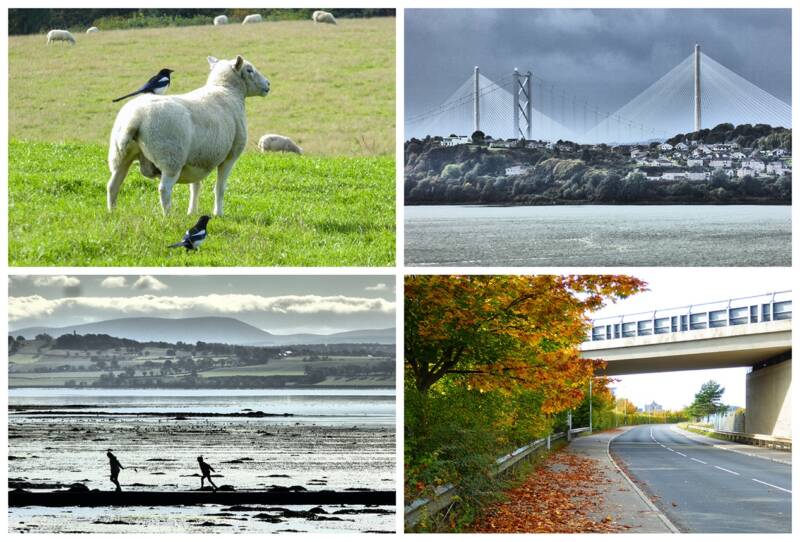
Multicoloured rows of houses, and the massive outline of a bear ploughed into a Newburgh hillside. Folk scavenging for agates at Balmerino, a big yellow castle in Newport, and the peculiar precision of the old Fife mileage stones (Newport 0, Largo Pier 14 ¼).
And my personal favourite, the recurring boat-turned-flowerbed motif along the entire coast, best of which was the blue and yellow boat in East Wemyss, piloted by minions.
Special mention too for the kindness of strangers, for the considerate farmer who chaperoned me through his field of frisky cows by getting me to walk behind his 4×4, as he drove through and parted the herd like Moses parting the Red Sea.
Course, I’d be giving a false impression if I presented the whole route as pure undiluted joy. A walk this long obviously isn’t. Lengths of path designed more with bikes and active travel in mind understandably tend to be hard and straight. This means there are long sections that are great for bikes but, for walkers like me, are more like endurance tests than pleasurable strolls. And yes, there are also lengthy sections alongside busy A-roads. Doubtless if you were doing just small sections purely for pleasure, these aren’t the places you’d choose. For completeness of course, there’s no avoiding them, but like I say, there is ALWAYS something of interest around the next corner.
And so that’s my enduring feeling of what really sets the Fife Coastal Path apart, and why I’ll remember Summer 2022 so fondly. It was a summer of contrasts, a beguiling mix of everything: rural, urban, natural, not-so-natural. It’s like I’ve always said, a walk through Fife is a walk through life!
Hmm. I think I might have to do it all again….but anti-clockwise!
SUPPORT THE FIFE COASTAL PATH
Without the Fife Coast and Countryside Trust (FCCT), an independent registered charity, the Fife Coastal Path wouldn’t exist. They waymark the whole thing, manage many of the most popular beaches, conserve precious coastal habitats, repair paths, provide car parks and toilets. So if you love the coastal path and want to give something to help in its upkeep, please consider a donation to the Trust. A little goes a long way!
